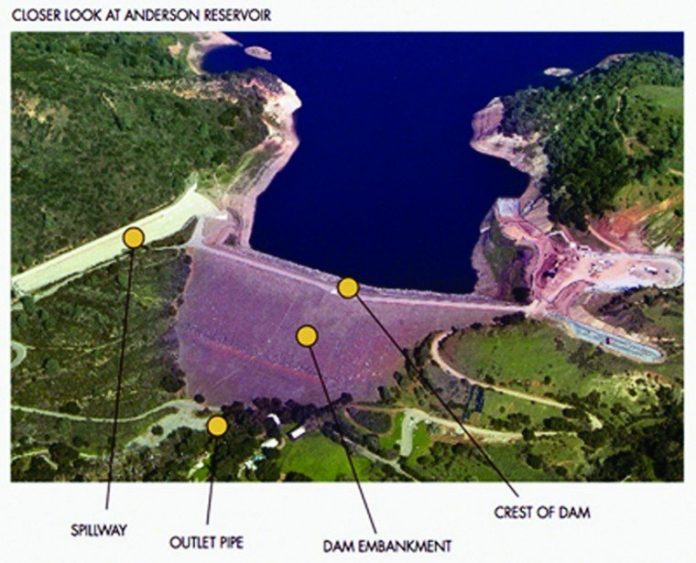Experts are in the process of evaluating the design alternatives to retrofit Anderson Dam, which has been classified as seismically unsound.
Staff from the Santa Clara Valley Water District will discuss several options to repair Anderson Lake’s earthen dam at 6:30 p.m. Tuesday at a community meeting at the Morgan Hill Community and Cultural Center, 17000 Monterey Road.
The district determined in 2011, after an independent study conducted two years earlier, that Anderson Dam would not withstand a major earthquake, and the crest of the dam could slump in such an event, leaving Morgan Hill underwater within minutes.
The district’s study determined this damage could occur in the event of a 7.25-magnitude earthquake on the Calaveras fault, which is about 1.2 miles from the dam, district staff said. Since 2009, as a precaution the reservoir level has been maintained at least 25.5 feet below the crest of the spillway, which corresponds to about two-thirds capacity of the reservoir.
The district’s staff also presented the current results of an ongoing consultants’ study of the seismic retrofitting options at an SCVWD board meeting Tuesday morning.
The consultants – HDR and Black & Veatch – and district staff have spent the last six months evaluating the best way to bring Anderson Dam up to current safety standards. They came up with 19 different repair options, but narrowed those down to six possibilities that they presented to the board.
All six repair alternatives include “buttressing” both the upstream and downstream sides of the dam with more earth and rocks, increasing the capacity of the spillway, and replacing the existing outlet pipe at the bottom of the dam with a more stable conduit enclosed in an underground tunnel, according to Chris Mueller of Black and Veatch.
The alternatives differ mainly in the exact route of the new outlet pipe, and in whether the spillway would be widened or deepened in order to increase its capacity, Mueller noted.
District staff and consultants will continue to evaluate the six repair alternatives and later this year will present a single recommended option for the board’s approval. After that will begin the environmental and design phases. Construction will not start before early 2016, Mueller said.
The massive construction project will last up to three years and require drawing down the reservoir “significantly,” closing the district’s largest reservoir to boating, fishing and other recreational activities for at least two years, Mueller said.














